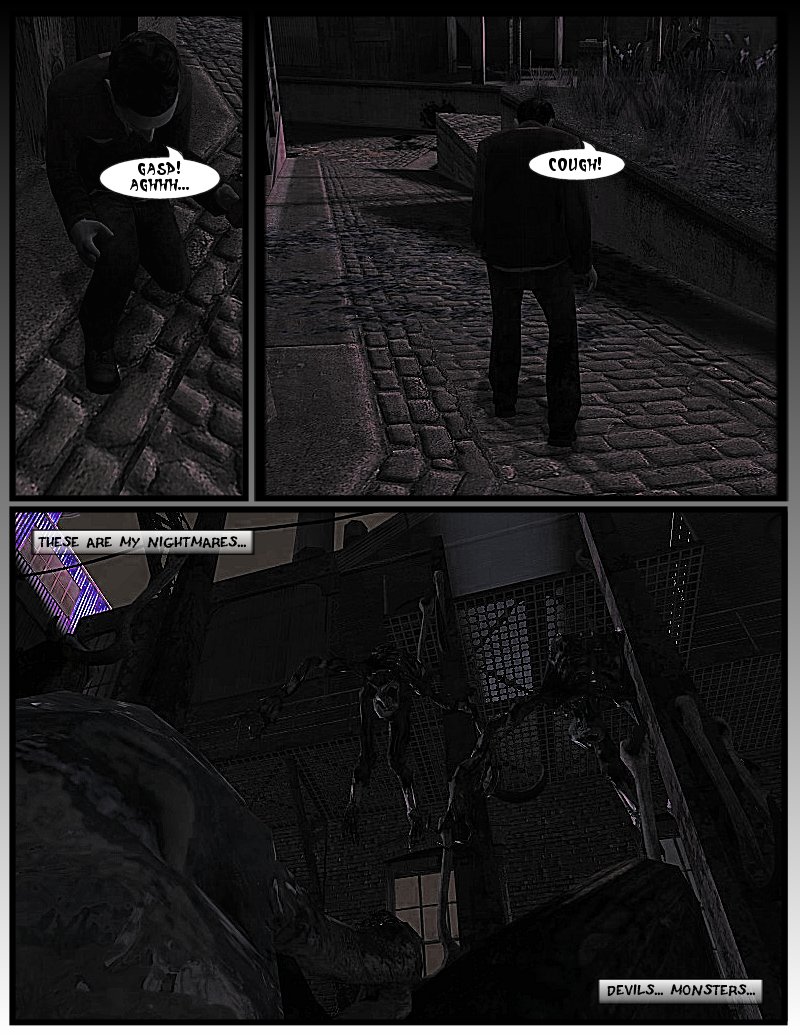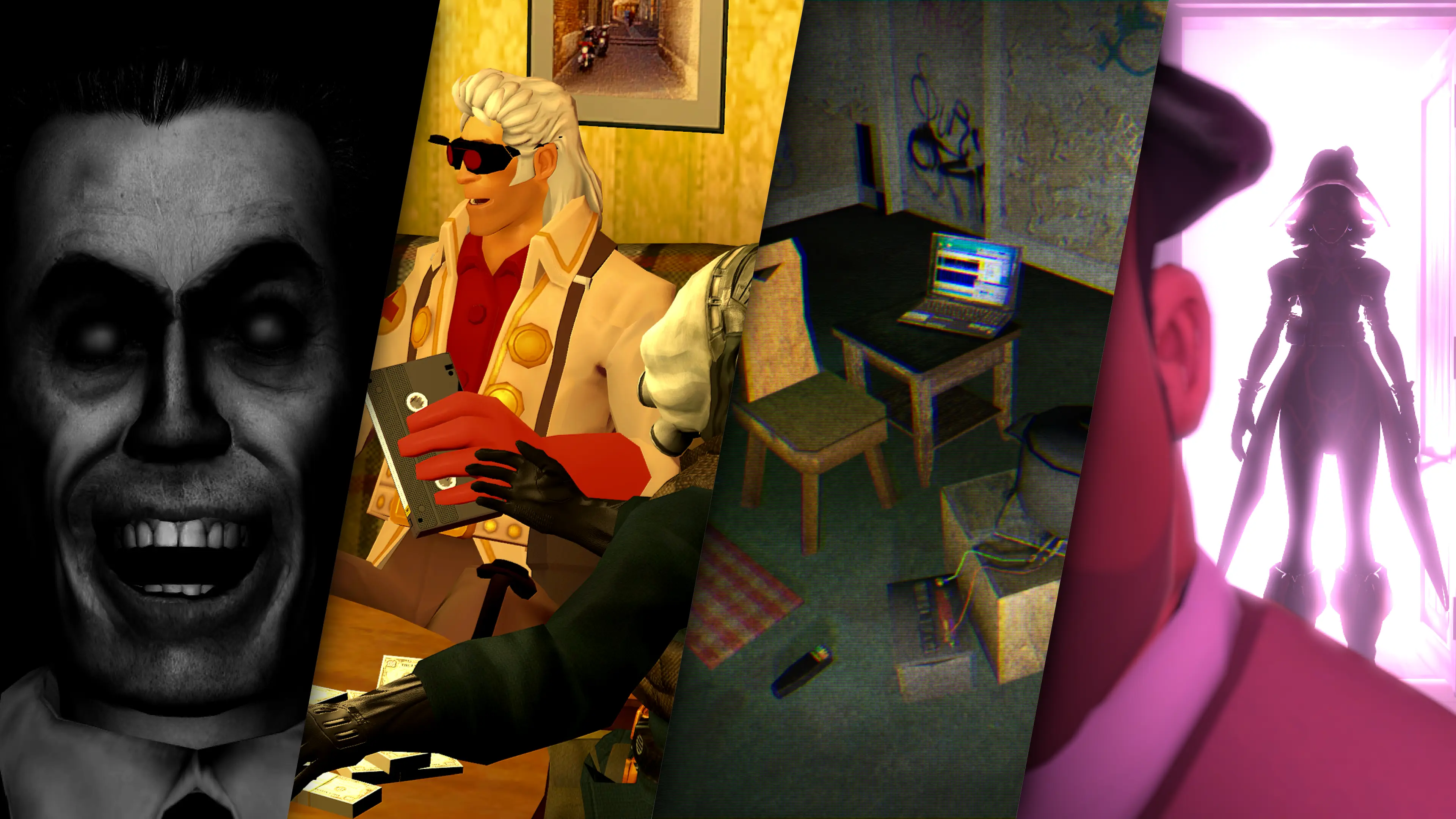Due to the sheer size of the Metrocop comic archive, it’s easy for great comics to get lost and be overlooked by all the choice. The Backlog is a way to showcase some of the best series in the archive that might otherwise not get their due attention. Just in time for Halloween, we’re doing a pilot episode for this possibly-recurring feature with a defining early Half-Life 2 horror comic.
I’m not gonna lie: this one is a personal favorite of mine and a comic I was delighted to revisit back in 2014, when the author very kindly shared it with me so it could be brought back online on Metrocop. That said, I’ll try to be as unbiased as possible, but hopefully still show you why this unassuming early comic is one of the all-time greats.
My Last Night in Ravenholm was created by Richard “Major.Dump” Boisvert in 2005, making this one of the very first Garry’s Mod and Half-Life 2 comics ever released. As such, it does suffer from the limitations of early experimentation with making comics using the Source engine, such as some awkward posing and pretty basic editing, although to a lesser extent than other early Garry’s Mod comics, such as Jeff.
That being said, if you can look past its limitations, My Last Night in Ravenholm absolutely holds up, in great part thanks to its writing, which, although not perfect—like most Garry’s Mod comics in the archive, it was written by a teenager taking his first steps in writing—, still grabs you by the throat and drags you down into the hell that is Ravenholm in its final days.
Horror noir: the story and tone
MLNiR follows the story of Richard, a refugee living in Ravenholm with his wife Andrea before the Combine make the decision to obliterate the town using weaponized headcrab canisters. While the comic does show its take on the decision-making behind such an event, it’s mostly a personal tale about Richard and his attempt to survive the trap town that Ravenholm became on that fateful night.
Exploring the backstory of Ravenholm has become a popular trope both within the Half-Life 2 community as well as officially, with not one but two known attempts at making a Ravenholm-centric Half-Life episode, but My Last Night in Ravenholm was perhaps the first community attempt at telling the story behind one of the most memorable sections of Half-Life 2.
What makes My Last Night in Ravenholm‘s writing truly engrossing is the blend of horror and noir, a very popular genre in early GMod comics, which is used with a very unique spin and to great effect here. The entire 10-part comic is narrated from Richard’s point of view, initially as if the whole thing were a flashback, but gradually switching to a present tense as things spiral out of control for Richard.

While at first this may seem like lazy or inexperienced writing, it follows the rest of the comic’s increasingly surreal and psychological tone. As things come to an head for Richard, especially in a gruesome twist midway through that I’d rather not spoil, his own point of view seems to grow increasingly disassociated, even deranged, almost as if the entire ordeal becomes an out-of-body experience for the protagonist.
The narration, in turn, highlights this disassociation, by increasingly focusing on Richard’s more guttural feelings and instincts, describing the zombies vividly as “devils” and “monsters”, rather than the human beings they once were. By the end of the series, Richard’s state of mind has unraveled enough that he suffers from side-effects such as hallucinations and paralysis (catatonia). The comic explicitly compares this to a bad dream or a nightmare, though they are also very similar to actual real-life symptoms of Post-Traumatic Stress Disorder. It’s a very effective portrayal of what a survivor could actually go through trying to escape a situation as terrifying and stressful as Ravenholm during its last days.
Richard himself has many hallmarks of a noir protagonist, in particular his increasingly fatalistic outlook and alienation from the events around him. He also displays a pragmatism not unlike some hard-boiled noir heroes, although, in this case, it grows out of Richard’s detachment from the horrors around him, as well as his character development throughout the ten parts of the comic—although perhaps “deconstruction”, rather than “development”, is the more apt term.
The noir comparisons also extend, in part, to the role of women in the comic. While no female character is treated as the traditional femme fatale, they are nonetheless motivators and objects of desire, in particular Richard’s wife, Andrea, who serves as the primary reason behind all of Richard’s actions in the comic. That said, female characters are few and far between and written pretty basically, no doubt the result of the times as well as the author’s own maturiy at the time of writing this.
On the other hand, while the blend of noir and horror tropes gives My Last Night in Ravenholm some long-lasting originality, it can’t be said to be actually scary. The horror, as it were, is more psychological and focused on “adult fears”, such as the loss of a loved one, which at least works well in this medium. The headcrab zombies themselves end up devolving into mere obstacles for Richard to somewhat easily get past, which is a missed opportunity.
The pacing is also generally very good, although it falters a bit around the middle, particularly in part 5, which is a relatively short (though hugely important) action scene, and part 7, which feels the closest to filler, and gets a bit repetitive close to the end. However, it certainly picks back up as it reaches its finale, with the last part being more of an epilogue or coda—and the last few pages introducing one final twist that ties it brilliantly into the events of Half-Life 2, and is still, to me, one of the most memorable fan-fiction moments in the series, right there with Apostasy‘s reveal of the mysterious cargo and Concerned‘s Nova Prospekt “chapter”.
Ultimately, even more than fifteen years removed from release, there’s still nothing quite like My Last Night in Ravenholm, and while the setting itself was done to death by both official sources and fan creations, this early GMod comic still manages to carve out an identity all its own that makes it well worth a read.
Posing and editing: not quite like a fine wine
As I mentioned earlier in this retrospective, where My Last Night in Ravenholm unfortunately stumbles is the actual production of the comic, namely, the posing and editing.

One important caveat, which applies to most early comics like Jeff and even Concerned, is that you need to keep in mind this was made in 2005. Back then, Garry’s Mod was in its infancy, not even a standalone product yet, and so was the community and its understanding of how to handle the Source engine. Lighting techniques were practically non-existent, much less custom models, so the whole project ends up having a very “vanilla” Half-Life 2 feel by necessity (which, personally, I find to be a pro, not a con).
Likewise, editing Garry’s Mod comics was still pretty much a new thing, and while there were certainly already some stellar examples (which I’ll come to in a moment), the community was mostly kids who were just figuring out how to use Adobe Photoshop, let alone create compelling layouts and understand the basics of dialogue and pacing.
That being said, you need only compare this to the author’s later efforts—namely, Chapter Zero of Apostasy and its subsequent chapters, posed by Major.Dump himself in late 2005 and early 2006—to understand the faults of MLNiR and see the author’s subsequent progression. Nothing is altogether offensive, either in posing or editing (although quite a few panels are oversharpened to hell, presumably as an artistic choice), but it is very much a product of its time and you have to look at it through that prism to appreciate it.
Final thoughts
It’s hard for me to look at My Last Night in Ravenholm removed from my own personal history with it: it was one of the first comics I found and read in the now-defunct PHWOnline website and, even decades later, remains one of my favorites. I know I’m not alone in this due to some attempts by other people at remaking the series with modern techniques, which would definitely improve its… let’s call them “aesthetic faults”.
It’s a classic, pure and simple. If you find it hard to stomach the stumbles of early Garry’s Mod comics, you probably won’t get very far into it, but you manage to overlook those and stick with it, you’ll find an engrossing, maybe even definitive take on the fall of Ravenholm. You’ll also never look at a certain minor NPC in Half-Life 2 the same way ever again.
One final fun fact: the author of the comic, Richard Boisvert, would eventually grow up to become a Cinematic Designer at BioWare, where he worked on high-profile games such as Dragon Age: Inquisition. Quite the career progress from making one of the first GMod comics, but not such a huge leap considering it’s basically the endgame of these humble machinima beginnings. That alone should tell you plenty about the talent involved in this comic.
My Last Night in Ravenholm is available in its entirely in the Metrocop comics archive. Whether you are a new reader or an old fan, let me know in the comments what you think of this classic Half-Life 2 horror comic.

